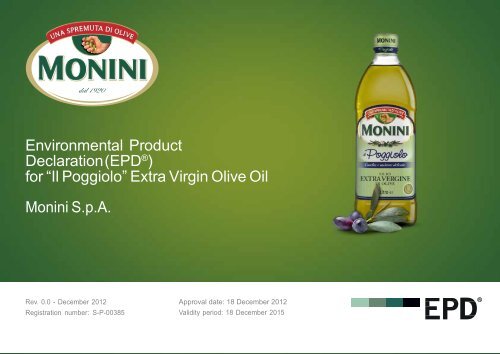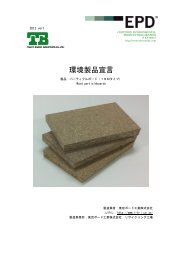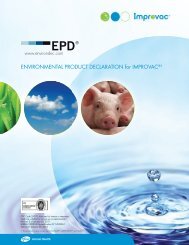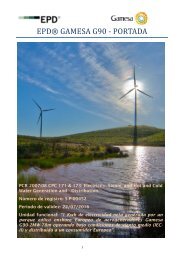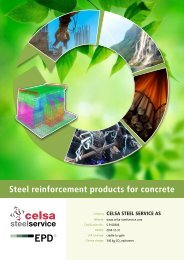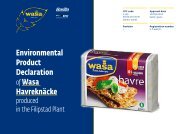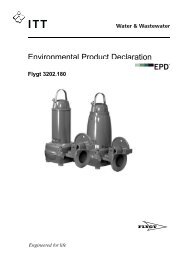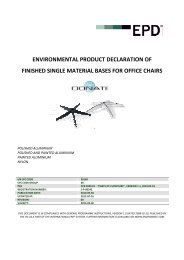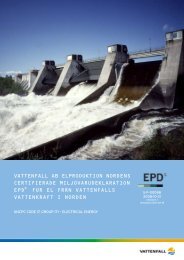Extra Virgin Olive Oil - Monini
Extra Virgin Olive Oil - Monini
Extra Virgin Olive Oil - Monini
- No tags were found...
You also want an ePaper? Increase the reach of your titles
YUMPU automatically turns print PDFs into web optimized ePapers that Google loves.
Environmental ProductDeclaration (EPD ® )for “Il Poggiolo” <strong>Extra</strong> <strong>Virgin</strong> <strong>Olive</strong> <strong>Oil</strong><strong>Monini</strong> S.p.A.Rev. 0.0 - December 2012Registration number: S-P-00385Approval date: 18 December 2012 ®Validity period: 18 December 2015
The All-Italian Story<strong>Monini</strong> EPD01 ® , December 2012of a Passionp. 2MONINI,THE ALL-ITALIAN STORYOF A PASSIONA passion for qualitythat dates back over a centuryThe <strong>Monini</strong> company is an Italian successstory based on tradition and quality. Thecompany was founded in 1920 by Zefferino<strong>Monini</strong>, who, following his entrepreneurialinstinct, decided to establish a business inthe town of Spoleto, in the Italian region ofUmbria. Thanks to its hills covered with olivegroves, from which an oil with an intense yetbalanced flavour is obtained, the Spoletoarea has always been dedicated tothe production of <strong>Extra</strong> <strong>Virgin</strong> <strong>Olive</strong> <strong>Oil</strong>.The passion that Zefferino <strong>Monini</strong> Sr.developed for olives at an early age led himto dedicate himself to the production of <strong>Extra</strong><strong>Virgin</strong> <strong>Olive</strong> <strong>Oil</strong>, whereby he founded thecompany "Zefferino <strong>Monini</strong> Olio di Oliva" in1930. The knowledge and consumption of<strong>Extra</strong> <strong>Virgin</strong> <strong>Olive</strong> <strong>Oil</strong> at the time was limited,and was locally confined exclusively to itsareas of production. Most Italians, above allin the larger cities, either out of habit or lackof knowledge, used almost exclusively regularolive oil, rather than the extra virgin variety.By deciding to market <strong>Extra</strong> <strong>Virgin</strong> <strong>Olive</strong> <strong>Oil</strong>beyond the confines of the Umbria region,Zefferino <strong>Monini</strong> launched a new trend inthe oil industry. Thanks to his initiative andhis passion for the natural product of hishomeland, together with the exceptionalquality of the oil obtained from the hills ofUmbria, Zefferino <strong>Monini</strong> succeeded in writingthe first page in the history of the <strong>Extra</strong><strong>Virgin</strong> <strong>Olive</strong> <strong>Oil</strong> market. Once brought to theattention of a wider audience, <strong>Monini</strong> extravirgin olive oil became increasingly popularand began to be demanded by customerseven further afield. The company ceasedoperations during the war as the product wassubject to rationing. Once the distribution offoodstuffs was deregulated in 1945, however,the company's operations continued withrenewed energy. It was at this time thatZefferino's sons, Giuseppe and Paolo, joinedthe company. Giuseppe and Nello flankedtheir father in his traditional laboratory,learning the all the tricks of the trade.At the time, shopkeepers sold the productin bulk. Anticipating the future needs of themarket, however, the first glass bottles beganflanking the traditional demijohns by the year1950.
The All-Italian Story<strong>Monini</strong> EPD01 ® , December 2012of a Passionp. 3A historic oil in modern times.Today, <strong>Monini</strong> is one of the leadingcompanies in the <strong>Extra</strong> <strong>Virgin</strong> <strong>Oil</strong> industry,boasting over 100 employees and a turnoverof nearly 125 million Euros in 2011. 90%of the total turnover is generated underthe <strong>Monini</strong> brand name. The strategythat Zefferino Sr. began in the 1920s wasstrengthened and enhanced by his son,Giuseppe, and is still being carried forwardby his grandchildren, Zefferino Jr. and MariaFlora. To this day, the family continues todiffuse the culture of <strong>Extra</strong> <strong>Virgin</strong> <strong>Olive</strong> <strong>Oil</strong>, notonly in terms of sales an distribution, but interms of education and awareness as well.The <strong>Monini</strong> family has been producing <strong>Extra</strong><strong>Virgin</strong> <strong>Olive</strong> <strong>Oil</strong> for three generations, usingexclusively mills whose hygiene conditions,processing systems and storage conditionssatisfy the company's stringent qualityrequirements. A company that's on thecutting-edge in terms of facilities, technologyand quality control, continuously driven bya passion for tradition, offering consumersa product of unrivalled quality. Like hisgrandfather before him, Zefferino <strong>Monini</strong> stillpersonally samples the company's productsto this day, selecting only the productsthat fully satisfy the company's high qualitystandards.
The <strong>Monini</strong><strong>Monini</strong> EPD02 ® , December 2012Groupp. 4THE MONINI GROUPNORTH AMERICA,POLAND AND AUSTRALIAThis propensity to diffuse the culture of<strong>Extra</strong> <strong>Virgin</strong> <strong>Olive</strong> <strong>Oil</strong> and to safeguard theart of Italian olive oil production as a symbolof Made in Italy quality, has rendered thisUmbrian company a reference point for theentire industry, even beyond the confines ofItaly itself.<strong>Monini</strong> North America Inc., with headquartersin Norwalk Connecticut, was founded in theyear 2000, and currently boasts an annualturnover of nearly 6 million U.S. dollars.The brand's presence throughout Europeis guaranteed by its subsidiary, <strong>Monini</strong>Polska, which was founded in 2008, withheadquarters in Poznan, Poland.In 2001, <strong>Monini</strong> also began heavily investingin modern olive-cultivation in the Australianstate of New South Wales, purchasing nearly700 hectares of land in a joint venture projectwith an Italian family that has been living inAustralia for over 50 years. A cutting-edgeproject with a unique plantation, not only interms of the type of crop cultivated, but alsoin terms of the methods used to cultivate andharvest the olives themselves. The plantationis home to over 106,000 trees of theFrantoio, Leccino, Pendolino and Coratinavarieties, which were planted in 2004 andhave literally flourished under the Australiansun.
The Company <strong>Monini</strong> EPD ® , December 2012p. 5THE COMPANYEnvironmental PolicyPackagingplantToday, <strong>Monini</strong> is a company that's on thecutting-edge in terms of facilities, technologyand quality control, upholding the Italian oliveoil tradition thanks to a responsible corporatemanagement model based on environmentalsustainability, business ethics and socialawareness. As evidenced by variousinterventions, <strong>Monini</strong> has recently undertakena major "eco-sustainability" project, includingthe installation of a photovoltaic system atthe production facility, the provision of energyfrom certified renewable sources, and the useof eco-friendly recycled glass packaging.Thanks to this policy, <strong>Monini</strong> has becomethe first large Italian company to obtain anEnvironmental Product Declaration (EPD ® ).<strong>Monini</strong>'s environmental policy is based on asimple philosophy: to never deprive nature orthe terrain of anything. Because it is preciselynature and the terrain that have provided thisSpoleto-based company with its preciousraw materials, allowing it to make a namefor itself over the past 100 years. <strong>Monini</strong>has assumed this exemplary commitmentto the environment and its natural fruits inorder to ensure that they are preserved forgenerations to come. It's the best possibleinvestment that the company could make inorder to preserve the values underlying the<strong>Monini</strong> olive oil tradition over time.The <strong>Monini</strong> S.p.A. production facility islocated in Spoleto (Italy), at Km 129 SSFlaminia.<strong>Monini</strong> S.p.A. produces more than30,000,000 litres of oil per year, approximately80% of which is <strong>Extra</strong> <strong>Virgin</strong> <strong>Olive</strong> <strong>Oil</strong>. 30% ofthe 2011 turnover was generated by exportsto over 30 countries. The company occupiesa total surface area of 22,000 square meters,10,000 of which are indoors, boasting sevenpackaging lines with a maximum productioncapacity of 15,000 litres/hour in variousformats, as well as a raw material filtrationline.
The Company <strong>Monini</strong> EPD3 ® , December 2012p. 6Supply chain control<strong>Oil</strong>s made from olives of different varieties,origins and maturity, and stored underdifferent conditions and for differenttime frames, naturally possess differentcharacteristics. For this reason, Zefferino<strong>Monini</strong> Jr., together with some of his closestexpert collaborators, select the best oilsin a special tasting room on a daily basis,recording the intensity and the differentflavour and olfactory characteristics of eachoil sampled. Approximately 15,000 oil tastingsessions are held each year during theselection and receipt of the raw materials,as well as before packaging. These controlactivities are not only limited to the rawmaterials themselves, but the quality of thefinal product is also guaranteed by the loyalty,collaboration, and control activities performedby the entire supply chain.Quality controlA state-of-the-art analytical laboratory monitorsthe quality and purity of each oil. These highlycomplex analyses are used to reveal thepresence of any oils other than olive oil, as wellas the presence of any undesired substancescontained within the oils themselves due totreatments with agrochemicals (pesticides,herbicides or fungicides) or simply due toenvironmental pollution.Modern analytical techniques and sophisticatedequipment allow for contaminants to bedetected in tenths of parts per billion: thismeans that it is possible to detect the presenceof even just one gram of a contaminantdissolved in 10,000 tonnes of oil !The <strong>Monini</strong> analysis laboratory performsapproximately 20,000 sets of analysis peryear, controlling approximately 90,000parameters. Most of the controls areperformed upon the incoming product, thusallowing for non-compliant batches of oil tobe rejected, while further controls are alsocarried out during the packaging stage.Subsequently, the quality levels of the oilsdestined for the national and internationalmarkets are sampled and monitored.
Calculation of environmental<strong>Monini</strong> EPD4 ® , December 2012performancep. 7CALCULATIONOF ENVIRONMENTALPERFORMANCE<strong>Monini</strong> Il Poggiolo <strong>Extra</strong> <strong>Virgin</strong> <strong>Olive</strong> <strong>Oil</strong>Bottle of 1 litre and 0.75 litersThis EPD ® refers to the product ofIl Poggiolo <strong>Extra</strong> <strong>Virgin</strong> <strong>Olive</strong> <strong>Oil</strong>Over the past three years, the company's IlPoggiolo <strong>Extra</strong> <strong>Virgin</strong> <strong>Olive</strong> <strong>Oil</strong> has generallybeen produced using olives grown in Italy,Spain, Portugal and Greece.The Il Poggiolo <strong>Extra</strong> <strong>Virgin</strong> <strong>Olive</strong> <strong>Oil</strong> ispackaged in bottles of light coloured glass;the primary packaging consists of two paperlabels applied to the bottle (front and back),an aluminium cap and a plastic spout; thestandard secondary packaging consists of aPVC capsule (Polyvinyl chloride), a tray madeof cardboard and shrink-wrap film, while thetertiary packaging is comprised of a palletand transparent outer film. In this EPD ® ,the density of the <strong>Extra</strong> <strong>Virgin</strong> <strong>Olive</strong> <strong>Oil</strong> isconsidered equal to 0.916 kg/litre.Functional unitIn accordance with PCR 2010:07, thefunctional unit for the life cycle refers toone (1) litre of <strong>Extra</strong> <strong>Virgin</strong> <strong>Olive</strong><strong>Oil</strong>, including its packaging .
Calculation of environmental<strong>Monini</strong> EPD04 ® , December 2012performancep. 8GEOGRAPHICALORIGIN<strong>Monini</strong> Il Poggiolo <strong>Extra</strong> <strong>Virgin</strong> <strong>Olive</strong> <strong>Oil</strong>The supply area for the production of <strong>Monini</strong> Il Poggiolo <strong>Extra</strong> <strong>Virgin</strong> <strong>Olive</strong> <strong>Oil</strong> corresponds to the following countries:(the areas of cultivation are listed in dark green)ItalyPuglia.SpainAndalusia, Murcia,Estremadura, Castilla y Leon,Navarra, La Rioja, Aragona,Catalogna, Castilla La Mancha,Madrid, Valencia.PortugalGuarda, Beja, Enora,Portalegre.GreeceCrete, Peloponnese.
Calculation of environmental<strong>Monini</strong> EPD04 ® , December 2012performancep. 9CHARACTERISTICSOF THE EXTRA VIRGINOLIVE OIL<strong>Monini</strong> Il Poggiolo <strong>Extra</strong> <strong>Virgin</strong> <strong>Olive</strong> <strong>Oil</strong>Il Poggiolo is a selection of oils obtained fromolives harvested at the time of peak maturityand is the ideal complement for cooking ordressing fresh, delicate and light dishes.In the KitchenFor all cooking purposes. For dressingcooked vegetables, delicate soups, sauces,white meat roasts, boiled meat and salads.NUTRITIONAL VALUESIn relation to various productionlots per 100 ml of productEnergyvalue824 kcal3389 kJMONOUNSATURATED fatsPOLYUNSATURATED69 g9 gProtein 0 g Cholesterol 0 mgCarbohydrates 0 g Dietary fibre 0 g(*)150% of the RDARecommended dailyallowanceFatof which SATURATED92 g14 gSodiumVitamin E0 g15 mg*
Calculation of environmental<strong>Monini</strong> EPD04 ® , December 2012performancep. 10ORGANOLEPTICCHEMICAL AND PHYSICALCHARACTERISTICS<strong>Monini</strong> Il Poggiolo <strong>Extra</strong> <strong>Virgin</strong> <strong>Olive</strong> <strong>Oil</strong>ORGANOLEPTIC CHEMICALAND PHYSICALCHARACTERISTICSAverageValueLimit Valuefor <strong>Monini</strong>Legal limitvalueReferencestandardFree acidity (% of oleic acid) 0.40 ≤ 0.5 ≤ 0.8 (1-3)Number of Peroxides (meqO2/kg) 9.0 ≤ 11 (Dec-May) ≤ 20 (1-2-3)≤ 13 (Jun-Nov)U. V. Spectrophotometry K 232 1.90 ≤ 2 (Dec-May)≤ 2.15 (Jun-Nov)≤ 2.50 (1-3)K 270 0.120 ≤ 0.14 (Dec-May) ≤ 0.22 (1-2-3)≤ 0.15 (Jun-Nov)∆K -0.002 ≤ 0.005 ≤ 0.01 (1-2-3)
Calculation of environmental<strong>Monini</strong> EPD04 ® , December 2012performancep. 11ORGANOLEPTIC AND CHEMICAL-PHYSICAL CHARACTERISTICS/1FATTY ACIDCOMPOSITION (%)AverageValueLimit Valuefor <strong>Monini</strong>Legal limitvalueReferencestandardC14:0 Myristic acid 0.01 - ≤ 0.05 (1-2-3)C16:0 Palmitic acid 11.74 - 7.5-20 (2-3)C16:1 Palmitoleic acid 1.09 - 0.3-3.5 (2-3)C17:0 Heptadecanoic acid 0.007 - ≤ 0.3 (2-3)C17:1 Heptadecenoic acid 0.11 - ≤ 0.3 (2-3)C18:0 Stearic Acid 2.93 - 0.5-5.0 (2-3)C18:1 Oleic acid 75.08 - 55-83 (2-3)C18:2 Linoleic acid 7.48 ≤ 11.5 3.5-21 (2-3)C18:3 Linoleic acid 0.67 ≤ 0.8 ≤ 1.0 (1-3)C20:0 Arachidic acid 0.40 - ≤ 0.6 (1-2-3)C20:1 Eicosenoic acid 0.26 - ≤ 0.4 (1-2-3)C22:0 Behenic acid 0.12 - ≤ 0.2 (1-2-3)C22:1 Erucic acid N.V. - 0.0 (1-2-3)C24:0 Lignoceric acid 0.05 - ≤ 0.2 (1-2-3)
Calculation of environmental<strong>Monini</strong> EPD04 ® , December 2012performancep. 12ORGANOLEPTIC AND CHEMICAL-PHYSICAL CHARACTERISTICS/2COMPOSITION IN TRANS FATTYACIDS ( %)AverageValueLimit Valuefor <strong>Monini</strong>Legal limitvalueReferencestandardC18: 1T (elaidinic acid)0.01≤ 0.03≤ 0.05(1-2-3)C18:2t+ C18:3t 0.01 - ≤ 0.05 (1-2-3)Total sterols (mg/kg) 1400 - ≥1000 (1-2-3)TRIGLYCERIDESHPLCAverageValueLimit Valuefor <strong>Monini</strong>Legal limitvalueReferencestandardTrilinoein (%) 0.12 ≤ 0.3∆ECN42 -0.06 - ≤ 0.2 (1-2-3)Stigmastadienes (mg/kg) 0.03 ≤ 0.06 ≤ 0.10 (1-2-3)Alkyl esters (mg/kg) 25 ≤ 40 ≤ 75 (1-3)
Calculation of environmental<strong>Monini</strong> EPD04 ® , December 2012performancep. 13ORGANOLEPTIC AND CHEMICAL-PHYSICAL CHARACTERISTICS/3TRIGLYCERIDESHRGCAverageValueLimit Valuefor <strong>Monini</strong>Legal limitvalueReferencestandard(1) Reg. CE 2568/91 and subsequentamendments, Reg. CE 1429/92 and Reg.CE 796/02, Reg. CE 1989/03 and lastly Reg.702/2007/CE, Reg. 61/20111.2 Diglycerides 60.0 1 ≥ 70 (Dec-Mar)≥ 60 (Apr-Jul)≥ 50 (Aug-Nov)Waxes (mg/kg) 100 ≤ 150 ≤ 250 (1-2-3)≤ 0.5 (4) (2) Codex Alimentarius ALINORM 01/17; 17thsession of the codex committee on fats and oils.(3) International <strong>Olive</strong> <strong>Oil</strong> Council COI/T.15/NCno.3 rev. 1 of the 05/12/2003Halogenated solvents (mg/kg) 0.02 - ≤ 0.2 (1-2-3)(4) Internal methodTotal polyphenols (mg/kg) 200 ≥ 150ORGANOLEPTIC EVALUATION(panel test)AverageValueLimit Valuefor <strong>Monini</strong>Legal limitvalueReferencestandardMedian defect 0 Md=0 (1-2-3)Median for "fruity" 3 Mf>0 (1-2-3)Panel Test 6.7 ≥ 6.5 6.5 Reg. 2568/91CEE
Calculation of environmental<strong>Monini</strong> EPD04 ® , December 2012performancep. 14ORGANOLEPTIC AND CHEMICAL-PHYSICAL CHARACTERISTICS/4MAINRESIDUAL CONTAMINANTSAverageValueLimit Valuefor <strong>Monini</strong>Legal limitvalueReferencestandardPAH: PolycyclicAromaticHydrocarbonsmg/tonB(a)P 0.0 < standard limitvaluesB(a)P 1.9 sum < standard limit 10B(a)A of the total valuesB(b)F of the 4 PAHCHR2Reg.1881/2006/EUandsub. Amend.Phthalates(mg/kg)2.52 totalsum of 8phthalatesexamined3.0 (DEHP)5.0 (forevery otherindividualPhthalate)- -Agrochemicals(mg/kg)< standardlimitvalues< standardlimitvaluesThoseof the referencestandardsM.D. 27/08/2004andsub. Amend.
Calculation of environmental<strong>Monini</strong> EPD04 ® , December 2012performancep. 15BOUNDARIESOF THE SYSTEM/1Upstream, coreand downstream processesIn accordance with PCR 2010:07, the lifecycle of the <strong>Extra</strong> <strong>Virgin</strong> <strong>Olive</strong> <strong>Oil</strong> is dividedinto the Upstream, Core andDownstream phases.The Upstream phase includesthe following processes:• The operations required for theestablishment of the olive groves and thetransformation of the terrain's use were nottaken into consideration because the lifecycle of an olive grove is greater than 25years.• The production of the olives used later inthe Core process, involving the followingprocesses:- The production of the inputs utilized, suchas for example, fertilisers and agrochemicalproducts.- Waste management.The use of the wood resulting from pruningor from the end of the olive trees' life cycle.- The transportation of the inputs to theregion and to the olive production sites.- The auxiliary materials used to harvest theolives (nets, cages, detergents, etc.).- The production of the fuel and electricityused at the plantations.- The transportation of the olives to the mill.- The extraction and use of the water.
Calculation of environmental<strong>Monini</strong> EPD04 ® , December 2012performancep. 16BOUNDARIESOF THE SYSTEM/2Upstream, coreand downstream processesThe Core phase includesthe following processes:• The extraction of the oil from the olives.• Waste management.• The preservation of the oil.• Transportation to the packaging plant.• The packaging of the oil at the<strong>Monini</strong> facility in Spoleto.• The production of the packaging materials.The Downstream phase includesthe following processes:• Transportation from the final production/storage site to a distributionplatform.• Transportation to the retailer.• Waste management.• The use of the product.• The recycling or disposalof the packaging/materials after use.• The transportation of the raw materials andenergy inputs to the Core process.
Calculation of environmental<strong>Monini</strong> EPD04 ® , December 2012performancep. 17BOUNDARIES OF THE SYSTEM/3Energy sources Chemicals Auxiliary Materials FuelsUPSTREAM CORE DOWNSTREAMCultivation and harvesting Crushing and Packaging Distribution and end of lifeMaterials in output:<strong>Olive</strong> Pomace
Calculation of environmental<strong>Monini</strong> EPD04 ® , December 2012performancep. 18DATA QUALITYThe inventory analysis was conducted usingspecific data from: <strong>Monini</strong> S.p.A. and fromthe companies involved in the study relatingto the cultivation and harvesting of the olives,oil extraction and preservation, transportationto the bottling plant and the packaging anddistribution of the product.Selected generic data was also used from:• The ECOIL project: Life CycleAssessment as a Decision Support Tool forthe Eco Production of <strong>Olive</strong> <strong>Oil</strong>.• International databases (in particularEcoinvent 2.2) with regard tothe processes for the production of semifinishedproducts, packaging materials,electricity and heating and of the means oftransport, as well as in relation to the watersupply and end of life.• Documents published by Terna relating tothe Italian production of electricity in2009, used to update the coefficient ofgreenhouse gas emissions of the Italianenergy mix.Carbon Trust documents relating tothe percentage of oils and fats not• consumed and disposed of, from OECDCompendiums for the amount of glassrecycled worldwide, from Eurostat for theamount of waste recycled and disposed of.In addition, the data relating to thetransportation distances was calculated usingthe on-line Google Maps and Sea Distancescalculator, respectively for the calculation of thedistances of transportation by sea and land.The <strong>Monini</strong> supply chainThe direct relationship with the privateor cooperative mill (sometimes throughthe figure of a mediator to coordinate thelogistics and financial aspects) does notcontribute to a situation that is conduciveto data collection for the process unit oftransforming the harvested olives into oil(mill) and even less so for the process unitregarding the plantation involved in thecultivation of the olive trees. This situationhas been exacerbated by the economiccrisis, especially in Greece, where in facta number of <strong>Monini</strong>'s producers (includinghistorical) have gone out of businessValidity of the EPD ®This EPD ® refers to the geographical area ofEurope and remains valid until 18 December2015.Comparison of EPDs ® withinthe same product categoryEPDs ® within the same product category,but referring to different programs, cannot becompared. The oils included in this documentare based on the specification PCR 2010:07version 1.0 dated 27-04-2010.
Calculation of environmental<strong>Monini</strong> EPD04 ® , December 2012performancep. 19CULTIVATIONAND HARVESTINGOF THE OLIVES/1Puglia, ItalySpainIn terms of <strong>Extra</strong> <strong>Virgin</strong> <strong>Olive</strong> <strong>Oil</strong> production,Puglia is Italy's leading olive oil producingregion. The region's most productiveprovinces are those of Foggia, Bari andBarletta-Andria-Trani. On the plains ofTavoliere, the olive growing process is aform of specialized farming with a regularline configuration, incorporating an irrigationsystem with the vase pruning system,and harvesting is mainly performed usingpneumatic combs. The olive-growingtechniques in the provinces of Bari andBarletta-Andria-Trani tend towards a moremodern style of olive-growing, with thetree arrangements assuming an intensiveand fairly regular configuration, with 280-300 trees/ha cultivated using the vasepruning system. Harvesting is performedmechanically, using harvesting machinery.In Spain there are two systems ofcultivation: traditional and super intensive. Thecultivars grown according to the traditionalsystem are the Picual and Cornicabravarieties, which are still found in the areasof Jaen (Andalusia) and Toledo/Ciudad Real(Castilla la Mancha). With regard to the superintensive system, there are three cultivars, theArbequina, Arbosana and Koroneiki varieties,with reduced vegetative development, to thepoint that they are planted with a density of1,600 -2,000 trees/ha.The form of tree cultivation consists in acentral axis, supported by a brace and bythe lateral growth of the branches along thewire stretching across the row between thesupports.Pruning is aimed at removing any superfluousgrowth and is performed manually withelectric saws or else mechanically at thetop (topping) using disc blades. The latterpractice allows for the proper use of the rowstraddlingmachinery used for harvesting.These super-intensive olive groves areequipped with localised distribution irrigationsystems, through which fertilisers are alsodistributed to the soil.The trees are fertigated 5-6 times a yearusing a localised distribution system.Various foliar fertilisers are employed, whiletreatments against flies (dimethoate) and themore frequent cryptogammic diseasesare also performed.
Calculation of environmental<strong>Monini</strong> EPD04 ® , December 2012performancep. 20CULTIVATIONAND HARVESTINGOF THE OLIVES/2GreecePortugalIn Greece, the areas dedicated to thecultivation of olive groves have increasedsteadily over the years, thanks to the plantingof new high-density rows of 250-300trees/ha. The olive groves involved in theproduction of olive oil have been widely usedin many semi-mountainous and coastal areas(especially in Crete and the Peloponnese),and several low stem varieties have becomewidely popular, such as the Koroneiki, theleader oil cultivar in the country, cultivatedfrom a sapling.The tendency is to enhance productionthrough mechanisation, land levelling andlocalised irrigation, using the wells belongingto the various farms.The ancient olive groves with large centuriesoldtrees have been replaced by newand intensive plantations, while the moretraditional plantations can still be foundon the smaller islands and in the highermountainous regions.Cultivation of the olive tree in Portugal hasadvanced considerably in recent decadesthanks to the exploitation of EU funding.It predominantly involves intensive andsuper-intensive fully mechanised cultivationtechniques, with the plant-by plant-irrigationof three main cultivars, which, in orderof importance, are the Arbequina, theFenugreek and the Cobrançosa varieties.
Calculation of environmental<strong>Monini</strong> EPD04 ® , December 2012performancep. 21EXTRACTIONOF THE OIL FROM THE OLIVES/1Washing, crushingand malaxationThe methods for obtaining <strong>Extra</strong> <strong>Virgin</strong> <strong>Olive</strong><strong>Oil</strong> are almost identical in all the countriestaken into consideration, with the exceptionof certain differences linked to local traditions.The only discrepancy lies in the fact thatin Italy a three stage centrifugation systemis used rather than the more modern andecological two-stage system, which is nowalmost universally employed.Washing and pressingWhen the olives arrive at the mill they areimmersed in a tank of water or, in modernplants, in special washing machines thatmaintain forced water movementin order to improve the results of theoperation. After washing, the next step isthe crushing, which in modern continuouscyclefacilities is carried out using a hammercrusher. With this system, the pulp is brokendown by the impacts of high-speed rotarydevices, and only in part by the mechanicalaction of the pit's fragments.The processing is performed within anextremely short time frame.MalaxationMalaxation or mixing is an operation thatfollows crushing, the purpose of which is tobreak down the emulsion between water andoil, thus allowing the micelles of oil to mergeinto larger droplets, which tend to separatespontaneously from the water. This is performedin machines called mixers or maloxers.The technical reference parameters duringthe mixing stage are the temperatureand the duration. The temperature is criticalfor the yield in the subsequent extractionprocess, and is closely related to the stabilityof the water-oil emulsion. With a low degree ofemulsification, malaxation can be performedat temperatures slightly higher than theambient temperature (from 22-24°C to 27°C);this is referred to as malaxation or coldextraction. With more stable emulsions, a moreaggressive heating of the paste is required,with temperatures ranging from 27°C to 30°C.The yield of the extraction increases with thetemperature of the malaxation, but the qualityof the paste decreases once the temperatureof 30°C is reached.
Calculation of environmental<strong>Monini</strong> EPD04 ® , December 2012performancep. 22EXTRACTIONOF THE OIL FROM THE OLIVES/2From malaxationto centrifugationCentrifugationThe olive paste resulting from the malaxationprocess is subjected to centrifugation in arotating conical drum, with a horizontal axiscommonly referred to as a decanter.Due to the different specific weights ofwater, oil, and olive pulp, the centrifugationseparates them over 2 to 3 phases. The3-phase decanter is the most consolidatedand utilized type found in Italy.In this case, three parts are separated bycentrifugation:• the olive pomace;• the oil must, containing a small amount ofwater;• the vegetation water, containing a smallamount of oil.This system requires the oil paste to bediluted in advance with mains water. The2-phase decanter is widespread throughoutSpain, Portugal and Greece, and differs fromthe 3-phase decanter due to the decreaseduse of water.The centrifugation process separates onlytwo parts:• the olive pomace and the vegetation water;• the oil must, containing a small amount ofwater.The oil must obtained from the extractionalways contains a residual amount of water,which is separated by the effect of thedifferent densities of the two liquids throughdecanting or centrifugation.Vertical centrifugation is the system used inall plants to separate the oil from the water.In this process, which is performed in verticalcentrifugal separators, both the oil mustand the vegetation water obtained from thehorizontal centrifugation are processed.
Calculation of environmental<strong>Monini</strong> EPD04 ® , December 2012performancep. 23PACKAGINGOF THE OILFrom storageto shipmentStorage<strong>Monini</strong> S.p.A. has about 170 storage tanksfor a total capacity of 5,500,000 litres, allstainless steel, interconnected and equippedwith electronic level probes in order tocontinuously monitor the quantities of oilcontained and those transferred from onetank to another.All the tanks are temperature controlled andare connected to an inert gas (nitrogen)distribution system that ensures optimalproduct preservation.FilteringImmediately before packaging the oils aresubjected to a double filtration process.Filtering does not alter the quality andnutritional characteristics of the oil, but ratherensures better preservation over time.Packaging<strong>Monini</strong> S.p.A. has 7 modern packaging lines,with a daily average bottling capacity of200,000 litres, and a maximum capacity of260,000 litres over 24 hours. They allow theoil to be bottled in 100ml, 250ml, 500ml, 1L,3L, and 5L containers, in order to satisfy thevarious needs of the market.Every packaging line is equipped with videocameras, which systematically detect anyforeign bodies present within the containers,monitor the presence of the label and cap,and verify the production batch and the oillevel of each single container.Finally, ultra-modern automatic laser-guidedshuttles transfer the pallets of packaged oilto the warehouse, where they will await finalshipment.
Calculation of environmental<strong>Monini</strong> EPD04 ® , December 2012performancep. 24DISTRIBUTION AND USE PHASEThe final stages of the product's life cycleDistributionThe product is distributed throughout Italyand globally.The weighted average distance for thequantities distributed globally over the pastthree years has been calculated according tothe data provided by <strong>Monini</strong>.For foreign countries, it was calculated fromthe <strong>Monini</strong> production facility to the respectivecapitals. The weight of the <strong>Extra</strong> <strong>Virgin</strong> <strong>Olive</strong><strong>Oil</strong> and the packaging is 1.35 kg for the IlPoggiolo <strong>Oil</strong>.Use phaseThe use phase of the <strong>Extra</strong> <strong>Virgin</strong> <strong>Oil</strong> isexcluded according to the PCR, however,a percentage of oil which may not beconsumed or disposed of after use is takeninto consideration (for example, in cooking);nevertheless, the values obtained from theCarbon Trust data base, equal to 21% in theUK, and 25% in the USA, are attributed to theentire sector of fats used by industry (foodpreparation, food cooking and frying, thepreparation of vegetable oil food preserves)and restaurants (essentially frying, but alsoincluding food cooking), where the productthat has not been consumed or disposed ofis relevant.With regard to the <strong>Monini</strong> <strong>Extra</strong> <strong>Virgin</strong> <strong>Oil</strong>marketed in the retail sector, the amountsof product that are not consumed ordisposed of are limited to those remainingin the packaging following use (estimatedat most to be 0.5% for a 1-litre bottle) andthe residues eliminated when washing thedishes after a meal (in even more irrelevantquantities).According to the OECD Compendium 2006-2008 document, the 15 countries belongingto the European Union at the time recycled65% of their glass bottles; this datum wasalso used for non-European Countriesas it is specific to glass. According toEurostat, in the 27 countries now belongingto the European Union, the disposal of wastein landfills and by incineration (with andwithout energy recovery) is respectively 54%and 46%; these percentages were also usedfor non-European countries because otherdata is not available. Again according toEurostat, the percentage of waste recyclingin the 27 countries of the European Union isequal to 48%; Eurostat figures were used todefine the end scenario of other packagingmaterials as well (the bottle cap, etc.).The processes of waste disposal in landfillsand via incineration were obtained from theEcoinvent database and are specific for thepackaging material; for the recycling process,only transportation assumed to be equal to100 km, covered by trucks with capacitiesranging from 16 to 32 tonnes, was taken intoconsideration.
04Calculation of environmentalperformanceENVIRONMENTAL PERFORMANCEList of the impact categories/1<strong>Monini</strong> EPD ® , December 2012p. 25The environmental performance of <strong>Monini</strong>products, as indicated below, is basedon the Life Cycle Assessment (LCA)methodology, and was calculated inaccordance with the ISO 14040 and14044 standards, the international EPD ®system and PCR 2010:07. Themanagement and updating of theenvironmental data concerning the EPD ®products are regulated by a specialprocedure within the Manual for the<strong>Monini</strong> management systems.Environmental impact indicatorsThe purpose of the impact assessment isto highlight the extent of the environmentalchanges that occur due to the atmosphericemissions and resource consumptionassociated with the production activities.The fundamental objective is to attribute theconsumption and emission levels obtainedduring inventory to specific impact categories.The list of impact categories isprovided belowConsumption of resourcesCalculation of the amounts of energy andnon-energy resources generally utilizedthroughout the entire life cycle of theproducts. These are divided into renewableand non-renewable energy sources, as wellas water consumption.Global warmingThis is caused by the presence ofgreenhouse gases in the atmosphere,which absorb the infrared radiation emittedby the earth, thus resulting in an averagetemperature increase. The anthropogenicgreenhouse gas which causes most concernis CO . The method for characterizing the2impacts of greenhouse substances is basedon that of the Intergovernmental Panel onClimate Change (IPCC), which uses kilogramsof equivalent CO over a time frame of 1002years (GWP 100 years, Global WarmingPotential) as an impact indicator. GWP isbased on a relative scale that compares thegas in question to an equal mass of CO ,2whose GWP is by definition equal to 1. CO2of biogenic origin has not been taken intoconsideration since the carbon balanceis nil if considered throughout the life cycle.Thinning of the ozone layerOzone is the gas present in the stratospherewhich serves to protect the earth from theultraviolet rays emitted by the sun. The breakingdown of the ozone molecules results in ahole in the protective layer, and this happensdue to the presence of a number of unstablecompounds, such as CFC and HCFC, which,having reached the stratosphere, are brokendown by the ultraviolet rays, thus releasingchlorine which in turn attacks the ozone.The method for characterizing the impactsof harmful substances on the ozone layer isbased on that of the World MetereologicalOrganisation (WMO), which uses kg ofequivalent CFC-11 (ODP, Ozone DepletionPotential) as an impact indicator. ODP is basedon a relative scale that compares the gas inquestion to an equal mass of CFC-11, whoseODP is by definition equal to 1.
04Calculation of environmentalperformanceENVIRONMENTAL PERFORMANCEList of the impact categories/2<strong>Monini</strong> EPD ® , December 2012p. 26Formation of photochemical smogforests and oceans to decrease.characterizing the impacts of eutrophicationThis is a phenomenon typical of peak hours The method for characterizing acidification is based on that of the Leiden Environmentalin big cities, which is quite pronounced in the impacts is based on that of the LeidenSciences Centre, NL (CML), which usessummertime, when the sun's rays cause the Environmental Sciences Centre, NL (CML), kg of PO as an impact indicator (NP,4unburned hydrocarbons and nitrogen oxides which uses kg of equivalent SO (AP, Nutrification Potential).present in the exhaust fumes to react, thusresulting in harmful ozone. The method forcharacterizing the impact of photo-chemicalsmog is based on that of the United NationsEconomic Commission for Europe (UNECE),which uses kg of POCP (photo-chemicalOzone Creation Potential) equivalent C H2 4as an impact indicator. POCP is based on arelative scale, which compares the substancein question to an equal mass of equivalentC H , the POCP of which is by definition2 4equal to 1.AcidificationThe acidification indicator is linked to theemission of certain acidifying substances intothe atmosphere, such as nitrogen oxides andsulphur oxides, which cause the pH of lakes,Acidification Potential) as an impact indicator.AP is based on a relative scale whichcompares the substance in question to anequal mass of equivalent SO , whose2AP is by definition equal to 1.EutrophicationIndicates a condition of accumulation ofnutrients within a given environment.Specifically an over-abundance of nitratesand phosphates in an aquatic environment,which causes the proliferation of microscopicalgae and, in turn, increased bacterial activity;The consequent lowering of oxygen insurface waters and in the soil causes adegradation of the environment which hasbecome asphyxiated and, in the long term,results in the death of fish. The method for2NP is based on a relative scale, whichcompares the substance in question toan equal mass of PO , whose NP is by4definition equal to 1.Depletion of abiotic resourcesThis indicator of environmental impactconcerns the protection of human healthand ecosystems; the indicator is expressedas a factor of abiotic depletion, i.e. boundto the extraction of minerals and fossilfuels, and is determined according to theconcentration of mineral reserves and theirrate of consumption; this indicator has aglobal geographical relevance.
04Calculation of environmentalperformanceENVIRONMENTAL PERFORMANCEList of the impact categories/3<strong>Monini</strong> EPD ® , December 2012p. 27Ecotoxicity of freshwatersThis indicator concerns the categoryof impact on fresh water ecosystems,due to the emission of toxic substances intothe air, water and soil.Ecotoxicity potential is calculated accordingto the USES-LCA model, which describesthe destination, the exposure and the effectsof the toxic substances. The time horizon isinfinite.The characterisation factor is expressedas 1.4-dichlorobenzene equivalent/kgof emission. The indicator is applied on aglobal, continental, regional and local scale.Ecotoxicity of sea waterThis indicator concerns the category ofimpact on seawater ecosystems, due to theemission of toxic substances into the air,water and soil.Ecotoxicity potential is calculated accordingto the USES-LCA model, which describes thedestination, the exposure and the effects ofthe toxic substances.The time horizon is infinite.The characterisation factor is expressedas 1.4-dichlorobenzene equivalent/kg Theindicator is applied on a global, continental,regional and local scale.Ecotoxicity of the soilThis indicator concerns the category ofimpact on seawater ecosystems, due to theemission of toxic substances into the air,water and soil.Ecotoxicity potential is calculated accordingto the USES-LCA model, which describesthe destination, the exposure and the effectsof the toxic substances. The time horizon isinfinite.The characterisation factor is expressedas 1.4-dichlorobenzene equivalent/kgof emission. The indicator is applied on aglobal, continental, regional and local scale.Human toxicityThis category concerns the effects of toxicsubstances on the human environment. Itdoes not include the health risks relatedto exposure at the workplace. Thecharacterisation factors and human toxicitypotential were calculated according to theUSES-LCA model, which describes thedestination, the exposure and the effectsof the toxic substances for an infinite timehorizon. For each toxic substance, thehuman toxicity potential is expressed as1.4-dichlorobenzene equivalent/kgof emission.The geographic scope of this indicatordetermines the destination of a substanceand can vary from a local to global scale.Use of the soil.This category concerns the effects followingthe conversion or occupation of land. Theimpact is expressed in m 2 per year.
04Calculation of environmentalperformance<strong>Monini</strong> EPD ® , December 2012p. 28EVALUATIONMETHODThe calculation method used for the LCA studyas a basis for this EPD ® is that described in thedocument entitledGPI for an international EPD ®Systemand the characterisation factors, usedto convert the data resulting from from the analysisof the life cycle inventory into categoriesof impact, are listed in the document entitledAppendix B:Conversion and characterisationfactors.
04Calculation of environmentalperformance<strong>Monini</strong> EPD ® , December 2012p. 2ENVIRONMENTAL PERFORMANCE/1<strong>Monini</strong> Il Poggiolo <strong>Extra</strong> <strong>Virgin</strong> <strong>Olive</strong> <strong>Oil</strong> 1-litre bottleCATEGORYOF IMPACTUnitUPSTREAM CORE DOWNSTREAMCultivation <strong>Oil</strong> Production Packaging* Distribution End of LifeLIFECYCLENon-renewablematerial resourceskg 0.061 0.003 0.610 0.00002 0.00002 0.674Inert rocks kg 0.000 0.000 0.414 0.000 0.000 0.414Sodium chloride kg 0.044 0.000 0.049 0.000 0.000 0.093Calcium carbonate kg 0.000 0.000 0.084 0.000 0.000 0.084Natural aggregates kg 0.000 0.000 0.043 0.000 0.000 0.043Other resources kg 0.017 0.003 0.020 0.000 0.000 0.040Environmental impact in reference to the functional unit of the 1-litre bottle of Il Poggiolo <strong>Extra</strong> <strong>Virgin</strong> <strong>Olive</strong> <strong>Oil</strong> and its packaging(*) <strong>Monini</strong> Plant in Spoleto (Italy)
04Calculation of environmentalperformance<strong>Monini</strong> EPD ® , December 2012p. 3ENVIRONMENTAL PERFORMANCE/1<strong>Monini</strong> Il Poggiolo <strong>Extra</strong> <strong>Virgin</strong> <strong>Olive</strong> <strong>Oil</strong> 1-litre bottleCATEGORYOF IMPACTUnitUPSTREAM CORE DOWNSTREAMCultivation <strong>Oil</strong> Production Packaging* Distribution End of LifeLIFECYCLENon-renewableenergy resourcesMJ eq 33.685 3.644 7.013 1.297 0.095 45.733Petroleum MJ eq 14.288 0.413 1.692 1.199 0.082 17.674Natural gas MJ eq 11.749 0.523 2.710 0.075 0.010 15.067Carbon MJ eq 5.676 2.439 0.131 0.014 0.001 8.261Other resources MJ eq 1.971 0.270 2.480 0.009 0.001 4.731Petroleum kg 0.327 0.009 0.039 0.027 0.002 0.404Natural gas m 3 0.301 0.013 0.069 0.002 0.000 0.386Carbon kg 0.246 0.132 0.005 0.001 0.000 0.384Environmental impact in reference to the functional unit of the 1-litre bottle of Il Poggiolo <strong>Extra</strong> <strong>Virgin</strong> <strong>Olive</strong> <strong>Oil</strong> and its packaging(*) <strong>Monini</strong> Plant in Spoleto (Italy)
04Calculation of environmentalperformance<strong>Monini</strong> EPD ® , December 2012p. 31ENVIRONMENTAL PERFORMANCE/2<strong>Monini</strong> Il Poggiolo <strong>Extra</strong> <strong>Virgin</strong> <strong>Olive</strong> <strong>Oil</strong> 1-litre bottleCATEGORYOF IMPACTUnitUPSTREAM CORE DOWNSTREAMCultivation <strong>Oil</strong> Production Packaging* Distribution End of LifeLIFECYCLERenewable materialresourceskg11827.720 528.104 157.351 10.997 1.687 12525.858Well water kg 6202.569 1.329 0.012 0.002 0.000 6203.913Water for hydroelectricproductionkg 3005.334 519.195 155.366 10.741 1.596 3692.232Salt water kg 2588.094 0.008 0.028 0.018 0.001 2588.149Other resources kg 31.723 7.572 1.945 0.236 0.089 41.564Environmental impact in reference to the functional unit of the 1-litre bottle of Il Poggiolo <strong>Extra</strong> <strong>Virgin</strong> <strong>Olive</strong> <strong>Oil</strong> and its packaging(*) <strong>Monini</strong> Plant in Spoleto (Italy)
04Calculation of environmentalperformance<strong>Monini</strong> EPD ® , December 2012p. 32ENVIRONMENTAL PERFORMANCE/2<strong>Monini</strong> Il Poggiolo <strong>Extra</strong> <strong>Virgin</strong> <strong>Olive</strong> <strong>Oil</strong> 1-litre bottleCATEGORYOF IMPACTUnitUPSTREAM CORE DOWNSTREAMCultivation <strong>Oil</strong> Production Packaging* Distribution End of LifeLIFECYCLERenewable energyresourcesMJ eq 0.658 0.163 0.477 0.002 0.000 1.300Energy from biomass MJeq 0.172 0.052 0.311 0.001 0.000 0.535Hydroelectric energy MJ eq 0.383 0.082 0.119 0.001 0.000 0.586Wind energy MJ eq 0.102 0.028 0.022 0.000 0.000 0.152Other resources MJ eq 0.001 0.001 0.025 0.000 0.000 0.027Environmental impact in reference to the functional unit of the 1-litre bottle of Il Poggiolo <strong>Extra</strong> <strong>Virgin</strong> <strong>Olive</strong> <strong>Oil</strong> and its packaging(*) <strong>Monini</strong> Plant in Spoleto (Italy)
04Calculation of environmentalperformance<strong>Monini</strong> EPD ® , December 2012p. 33ENVIRONMENTAL PERFORMANCE/3<strong>Monini</strong> Il Poggiolo <strong>Extra</strong> <strong>Virgin</strong> <strong>Olive</strong> <strong>Oil</strong> 1-litre bottleCATEGORYOF IMPACTUnitUPSTREAM CORE DOWNSTREAMCultivation <strong>Oil</strong> Production Packaging* Distribution End of LifeLIFECYCLEWater consumption m 3 11.228 0.528 0.157 0.011 0.002 12.525Electricity consumption MJ 1.318 0.604 0.004 0.003 0.000 1.929Global Warming100 yearskg CO2 eq 2.304 0.172 0.470 0.094 0.007 3.048Thinningof the ozone layermg CFC-11eq0.767 0.010 0.029 0.012 0.001 0.820Formationof photochemical smogg C2H4 2.139 0.092 0.233 0.066 0.010 2.540Acidification g SO2 eq 11.780 1.310 2.226 0.446 0.044 15.806Eutrophication g PO4 eq 3.685 12.349 0.295 0.106 0.026 16.460Environmental impact in reference to the functional unit of the 1-litre bottle of Il Poggiolo <strong>Extra</strong> <strong>Virgin</strong> <strong>Olive</strong> <strong>Oil</strong> and its packaging(*) <strong>Monini</strong> Plant in Spoleto (Italy)
04Calculation of environmentalperformance<strong>Monini</strong> EPD ® , December 2012p. 34ENVIRONMENTAL PERFORMANCE/3<strong>Monini</strong> Il Poggiolo <strong>Extra</strong> <strong>Virgin</strong> <strong>Olive</strong> <strong>Oil</strong> 1-litre bottleCATEGORYOF IMPACTUnitUPSTREAM CORE DOWNSTREAMCultivation <strong>Oil</strong> Production Packaging* Distribution End of LifeLIFECYCLEAbiotic resourcedepletiong Sb eq 14.637 1.429 3.090 0.593 0.043 19.791Ecotoxicityof freshwatersg 1.4-DBeq250.387 159.050 9.900 1.276 0.891 421.504Ecotoxicityof seawaterg 1.4-DBeq572720.550 332212.330 29972.239 3154.145 443.347 938502.611Ecotoxicityof the soilg 1.4-DBeq5.949 0.956 0.545 0.048 0.007 7.504Human toxicityg 1.4-DBeq1142.229 164.738 101.612 6.926 2.114 1417.620Land Use m 2 to 0.004 0.004 0.053 0.0001 0.00019 0.061Environmental impact in reference to the functional unit of the 1-litre bottle of Il Poggiolo <strong>Extra</strong> <strong>Virgin</strong> <strong>Olive</strong> <strong>Oil</strong> and its packaging(*) <strong>Monini</strong> Plant in Spoleto (Italy)
04Calculation of environmentalperformance<strong>Monini</strong> EPD ® , December 2012p. 35ENVIRONMENTAL PERFORMANCE/3<strong>Monini</strong> Il Poggiolo <strong>Extra</strong> <strong>Virgin</strong> <strong>Olive</strong> <strong>Oil</strong> 1-litre bottleCATEGORYOF IMPACTUPSTREAM CORE DOWNSTREAMLIFECYCLEUnitCultivation <strong>Oil</strong> Production Packaging* Distribution End of LifeRecycled Material/other useskg7.378 0.566 0.000 0.000 0.0007.964Hazardouswastekg 0.000 0.000 0.000 0.000 0.0000.000Other non-hazardouswastekg0.000 3.388 0.000 0.000 0.0003.388Renewable energyfrom wastekg0.000 0.112 0.000 0.000 0.0000.112Toxic emissionskg0.000 0.000 0.000 0.000 0.0000.000Environmental impact in reference to the functional unit of the 1-litre bottle of Il Poggiolo <strong>Extra</strong> <strong>Virgin</strong> <strong>Olive</strong> <strong>Oil</strong> and its packaging(*) <strong>Monini</strong> Plant in Spoleto (Italy)
04Calculation of environmentalperformance<strong>Monini</strong> EPD ® , December 2012p. 36ENVIRONMENTAL PERFORMANCE/1<strong>Monini</strong> Il Poggiolo <strong>Extra</strong> <strong>Virgin</strong> <strong>Olive</strong> <strong>Oil</strong> 0.75-litre bottleCATEGORYOF IMPACTUnitUPSTREAM CORE DOWNSTREAMCultivation <strong>Oil</strong> Production Packaging* Distribution End of LifeLIFECYCLENon-renewablematerial resourceskg 0.061 0.003 0.759 0.000 0.000 0.823Inert rocks kg 0.000 0.000 0.515 0.000 0.000 0.515Sodium chloride kg 0.044 0.000 0.061 0.000 0.000 0.105Calcium carbonate kg 0.000 0.000 0.105 0.000 0.000 0.105Natural aggregates kg 0.000 0.000 0.054 0.000 0.000 0.054Other resources kg 0.017 0.003 0.024 0.000 0.000 0.044Environmental impact in reference to the functional unit of the 0.75-litre bottle of Il Poggiolo <strong>Extra</strong> <strong>Virgin</strong> <strong>Olive</strong> <strong>Oil</strong> and its packaging(*) <strong>Monini</strong> Plant in Spoleto (Italy)
04Calculation of environmentalperformance<strong>Monini</strong> EPD ® , December 2012p. 37ENVIRONMENTAL PERFORMANCE/1CATEGORYOF IMPACTUnitUPSTREAM CORE DOWNSTREAMCultivation <strong>Oil</strong> Production Packaging* Distribution End of LifeLIFECYCLENon-renewableenergy resourcesMJ eq 33.701 3.643 8.702 1.396 0.116 47.559Petroleum MJ eq 14.295 0.413 1.792 1.290 0.101 17.891Natural gas MJ eq 11.755 0.523 3.553 0.081 0.012 15.924Carbon MJ eq 5.679 2.438 0.244 0.015 0.002 8.377Other resources MJ eq 1.972 0.270 3.114 0.010 0.001 5.367Petroleum kg 0.327 0.009 0.041 0.029 0.002 0.409Natural gas m 3 0.301 0.013 0.091 0.002 0.000 0.408Carbon kg 0.246 0.132 0.010 0.001 0.000 0.389Environmental impact in reference to the functional unit of the 0.75-litre bottle of Il Poggiolo <strong>Extra</strong> <strong>Virgin</strong> <strong>Olive</strong> <strong>Oil</strong> and its packaging(*) <strong>Monini</strong> Plant in Spoleto (Italy)
04Calculation of environmentalperformance<strong>Monini</strong> EPD ® , December 2012p. 38ENVIRONMENTAL PERFORMANCE/2<strong>Monini</strong> Il Poggiolo <strong>Extra</strong> <strong>Virgin</strong> <strong>Olive</strong> <strong>Oil</strong> 0.75-litre bottleCATEGORYOF IMPACTUnitUPSTREAM CORE DOWNSTREAMCultivation <strong>Oil</strong> Production Packaging* Distribution End of LifeLIFECYCLERenewable materialresourceskg11833.634 527.977 345.482 11.832 2.015 12720.940Well water kg 6205.670 1.329 0.019 0.002 0.000 6207.021Water for hydroelectricproductionkg 3006.837 519.070 342.621 11.556 1.904 3881.988Salt water kg 2589.388 0.008 0.030 0.019 0.002 2589.447Other resources kg 31.739 7.570 2.812 0.254 0.109 42.484Environmental impact in reference to the functional unit of the 0.75-litre bottle of Il Poggiolo <strong>Extra</strong> <strong>Virgin</strong> <strong>Olive</strong> <strong>Oil</strong> and its packaging(*) <strong>Monini</strong> Plant in Spoleto (Italy)
04Calculation of environmentalperformance<strong>Monini</strong> EPD ® , December 2012p. 39ENVIRONMENTAL PERFORMANCE/2<strong>Monini</strong> Il Poggiolo <strong>Extra</strong> <strong>Virgin</strong> <strong>Olive</strong> <strong>Oil</strong> 0.75-litre bottleCATEGORYOF IMPACTUnitUPSTREAM CORE DOWNSTREAMCultivation <strong>Oil</strong> Production Packaging* Distribution End of LifeLIFECYCLERenewable energyresourcesMJ eq 0.659 0.163 0.623 0.002 0.000 1.447Energy from biomass MJeq 0.172 0.052 0.385 0.000 0.000 0.609Hydroelectric energy MJeq 0.383 0.082 0.177 0.002 0.000 0.645Wind energy MJeq 0.102 0.028 0.030 0.000 0.000 0.161Other resources MJeq 0.001 0.001 0.031 0.000 0.000 0.033Environmental impact in reference to the functional unit of the 0.75-litre bottle of Il Poggiolo <strong>Extra</strong> <strong>Virgin</strong> <strong>Olive</strong> <strong>Oil</strong> and its packaging(*) <strong>Monini</strong> Plant in Spoleto (Italy)
04Calculation of environmentalperformance<strong>Monini</strong> EPD ® , December 2012p. 40ENVIRONMENTAL PERFORMANCE/3<strong>Monini</strong> Il Poggiolo <strong>Extra</strong> <strong>Virgin</strong> <strong>Olive</strong> <strong>Oil</strong> 0.75-litre bottleCATEGORYOF IMPACTUnitUPSTREAM CORE DOWNSTREAMCultivation <strong>Oil</strong> Production Packaging* Distribution End of LifeLIFECYCLEWater consumption m 311.834 0.528 0.345 0.012 0.002 12.720Electricity consumptionMJ1.319 0.603 0.004 0.003 0.001 1.930Global Warming100 yearskg CO2 eq 2.305 0.172 0.578 0.102 0.009 3.165Thinningof the ozone layermg CFC-11eq0.768 0.010 0.035 0.013 0.001 0.827Formationof photochemical smogg C2H4 2.140 0.092 0.277 0.071 0.013 2.593Acidification g SO2 eq 11.786 1.310 2.661 0.480 0.054 16.290Eutrophication g PO4 eq 3.687 12.346 0.355 0.114 0.032 16.533Environmental impact in reference to the functional unit of the 0.75-litre bottle of Il Poggiolo <strong>Extra</strong> <strong>Virgin</strong> <strong>Olive</strong> <strong>Oil</strong> and its packaging(*) <strong>Monini</strong> Plant in Spoleto (Italy)
04Calculation of environmentalperformance<strong>Monini</strong> EPD ® , December 2012p. 41ENVIRONMENTAL PERFORMANCE/3<strong>Monini</strong> Il Poggiolo <strong>Extra</strong> <strong>Virgin</strong> <strong>Olive</strong> <strong>Oil</strong> 0.75-litre bottleCATEGORYOF IMPACTUPSTREAM CORE DOWNSTREAMUnit Cultivation <strong>Oil</strong> Production Packaging* Distribution End of LifeLIFECYCLEAbiotic resourcedepletiong Sb eq 14.644 1.428 3.824 0.638 0.053 20.587Ecotoxicityof freshwatersg 1.4-DBeq250.512 159.012 15.050 1.373 1.094 427.041Ecotoxicityof seawaterg 1.4-DBeq573006.907 332132.783 42951.061 3393.731 541.387 952025.869Ecotoxicityof the soilg 1.4-DBeq5.952 0.956 0.694 0.052 0.008 7.661Human toxicityg 1.4-DBeq1142.800 164.699 127.692 7.452 2.592 1445.236Land Use m 2 to 0.004 0.004 0.064 0.000 0.000 0.073Environmental impact in reference to the functional unit of the 0.75-litre bottle of Il Poggiolo <strong>Extra</strong> <strong>Virgin</strong> <strong>Olive</strong> <strong>Oil</strong> and its packaging(*) <strong>Monini</strong> Plant in Spoleto (Italy)
04Calculation of environmentalperformance<strong>Monini</strong> EPD ® , December 2012p. 42ENVIRONMENTAL PERFORMANCE/3<strong>Monini</strong> Il Poggiolo <strong>Extra</strong> <strong>Virgin</strong> <strong>Olive</strong> <strong>Oil</strong> 0.75-litre bottleCATEGORYOF IMPACTUPSTREAM CORE DOWNSTREAMUnit Cultivation <strong>Oil</strong> Production Packaging* Distribution End of LifeLIFECYCLERecycled Material/other useskg7.382 0.585 0.000 0.000 0.000 7.967HazardousWastekg 0.009 0.000 0.000 0.000 0.000 0.009Other non-hazardouswastekg0.000 3.387 0.000 0.000 0.000 3.387Renewable energyfrom wasteToxic emissionskgkg0.000 0.112 0.000 0.000 0.000 0.1120.000 0.000 0.000 0.000 0.000 0.000Environmental impact in reference to the functional unit of the 0.75-litre bottle of Il Poggiolo <strong>Extra</strong> <strong>Virgin</strong> <strong>Olive</strong> <strong>Oil</strong> and its packaging(*) <strong>Monini</strong> Plant in Spoleto (Italy)
04Calculation of environmentalperformance<strong>Monini</strong> EPD ® , December 2012p. 43ENVIRONMENTAL PERFORMANCE/4<strong>Monini</strong> Il Poggiolo <strong>Extra</strong> <strong>Virgin</strong> <strong>Olive</strong> <strong>Oil</strong> Indicators per ha. Upstream ProcessesCATEGORYOF IMPACTUPSTREAM PROCESSESCATEGORYOF IMPACTUPSTREAM PROCESSESUnitIl Poggiolo1 litreIl Poggiolo0.75 litresUnitIl Poggiolo1 litreIl Poggiolo0.75 litresNon-renewablematerial resourceskg 7.4431093 820Non-renewableenergy resourcesMJ eq 602440 451830Inert rocks kg 0.000 0.000Sodium chloride kg 0.000 586.9213.530Calcium carbonate kg783 0.000Soil kg 0.000 0.0000.110Other resources kg 310 233Petroleum MJ eq 255540 191655Natural gas MJ eq 210132157599Carbon MJ eq 101515 76136Other resources MJ eq 35254 26441Petroleum kg 5840 4380Natural gas m 3 5388 4041Carbon kg 4400 3300
04Calculation of environmentalperformance<strong>Monini</strong> EPD ® , December 2012p. 44ENVIRONMENTAL PERFORMANCE/4<strong>Monini</strong> Il Poggiolo <strong>Extra</strong> <strong>Virgin</strong> <strong>Olive</strong> <strong>Oil</strong> Indicators per ha. Upstream ProcessesCATEGORYOF IMPACTUPSTREAM PROCESSESCATEGORYOF IMPACTUPSTREAM PROCESSESUnitIl Poggiolo1 litreIl Poggiolo0.75 litresUnitIl Poggiolo1 litreIl Poggiolo0.75 litresRenewable materialresourceskg 211535534 158651650Renewable energyresourcesMJ eq 11772 8829Well water kg 110931252 83198439Water for hydroelectricproductionkg 53749578 40312184Salt water kg 46287344 34715507Other resources kg 567361 425521Energy from biomass MJ eq 3077 2308Hydroelectric energy MJ eq 6848 5136Wind energy MJ eq 1828 1371Other resources MJ eq 18 14
04Calculation of environmentalperformance<strong>Monini</strong> EPD ® , December 2012p. 45ENVIRONMENTAL PERFORMANCE/4<strong>Monini</strong> Il Poggiolo <strong>Extra</strong> <strong>Virgin</strong> <strong>Olive</strong> <strong>Oil</strong> Indicators per ha. Upstream ProcessesCATEGORYOF IMPACTUPSTREAM PROCESSESCATEGORYOF IMPACTUPSTREAM PROCESSESUnitIl Poggiolo1 litreIl Poggiolo0.75 litresUnitIl Poggiolo1 litreIl Poggiolo0.75 litresWaterconsumption m 3 211535 158651Global Warming100 yearsThinning ofthe ozone layerFormation ofphotochemical smogkg CO2 eq 41201 30901kg CFC-11eq 0,014 0,010kg C2H4 38 29Acidification kg SO2 eq 211 158Eutrophication kg PO4 eq 66 49Abiotic resourcedepletionEcotoxicityof freshwatersEcotoxicityof seawaterEcotoxicityof the soilHuman toxicitykg Sb eq 262 196kg 1.4-DBeqkg 1.4-DBeqkg 1.4-DBeqkg 1.4-DBeq4478 335910242950 7682213106 8020428 15321Land Use m 2 to 75 56
05EnvironmentalCertification<strong>Monini</strong> EPD ® , December 2012p. 46ADDITIONAL ENVIRONMENTAL INFORMATION<strong>Monini</strong> S.p.A. certificationTYPE AND LEVEL OF CERTIFICATION CERTIFYING AGENCY YEAR OF 1 st ISSUEISO 9001:2008:standard for the management of quality systems1999British Retail Consortium: health & hygiene safetyfor private brand agri-food products2004International Food Standard: health & hygiene safetyfor private brand agri-food products2006UNI 10854 :1999: Design and application of aself-monitoring system based on the HACCP method2007ISO 22000:2008:Food safety management systems2010
05EnvironmentalCertification<strong>Monini</strong> EPD ® , December 2012p. 47ADDITIONAL ENVIRONMENTAL INFORMATION<strong>Monini</strong> S.p.A. certificationTYPE AND LEVEL OF CERTIFICATION CERTIFYING AGENCY YEAR OF 1 st ISSUEOHSAS 18001:2007:Health and safety management systems certification2009BIO:Production and packaging of organic products2001PDO:PDO production and packaging Umbria1998ORTHODOX UNIONKosher certificationRabbi MenachemGeank – CEO1992
06AdditionalInformation<strong>Monini</strong> EPD ® , December 2012p. 48INFORMATIONContactsFor further information<strong>Monini</strong> S.p.A.Vania Massarie-mail: vmassari@monini.comFrancesca Evangelistie-mail: fevangelisti@monini.comAmbiente Italia SrlAndrea Morettoe-mail: andrea.moretto@ambienteitalia.it<strong>Monini</strong> S.p.A.www.monini.comInternational EPD ® systemwww.environdec.comEPDs ® within the same product categorybut referring to differentprograms cannot be compared.Document valid until:18 December 2015Geographical Area of production: EuropeGeographical Area of distribution: Global
06AdditionalInformation<strong>Monini</strong> EPD ® , December 2012p. 49INSPECTIONRevision of the PCR conducted by:The Technical Committeeof the International EPD ® SystemPCR Moderator:George Michalopoulosparabem@hol.grIndependent auditof the declaration and the datain accordance with the ISO15025 standardExternal audit conducted by:Maurizio Fieschi - Individual VerifierContract managementFor EPD ® validation:Bureau Veritas Italia s.p.a.Accredited by:The Technical Committeeof the International EPD ® System
06AdditionalInformation<strong>Monini</strong> EPD ® , December 2012p. 50REFERENCES1 - ISO 14040:2006 Environmental management - Life cycle assessment - Principles and Framework2 - ISO 14044:2006 Environmental management - Life cycle assessment - Requirements and Guidelines3 - General Programme Instructions for Environmental Product Declarations, version 1.0 dated 2008-02-294 - PCR 2010:07, CPC Division 21537: <strong>Virgin</strong> olive oil and its fractions; version 1.0 dated 2010-04-275 - The ECOIL project: Life Cycle Assessment as a Decision Support Tool for the Eco Production of <strong>Olive</strong> <strong>Oil</strong>, 20066 - F. Dallari and G. Marchet (2008). Pallet Management7 - Energy statistics - Manual, (2004) IEA (International Energy Agency)8 - OECD Environmental Data - Waste Compendium 2006-08, OECD, 20089 - Evaluation of the life-cycle of the <strong>Monini</strong> <strong>Extra</strong> <strong>Virgin</strong> <strong>Olive</strong> <strong>Oil</strong> - LCA Report; Ambiente Italia S.r.l. November 2012Other information: Web site: International <strong>Olive</strong> <strong>Oil</strong> Council


